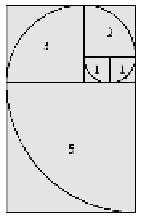Information Technology Reference
In-Depth Information
case of phyllotaxis, Fibonacci spirals and “golden angles” frequently occur. A Fi-
bonacci spiral, based on Fibonacci sequence, is given in Fig. 5.11. The most fre-
quent golden angle in phyllotaxis (the arrangement of leaves in stems) is 2
2
π
(
1
/
φ
)
,
52
o
.
The reason of such geometrical phenomena seems to be due to the optimal bal-
ance, realized by these patterns, between two opposite forces: i) a repulsive force
between nearby individuals (leaves which need to have enough space around to re-
ceive enough light without interference from other leaves), and ii) an attractive force
due to a whole population requirement (a tree tending to have the maximum number
of leaves on its branches).
.
approximately equal to 137
Fig. 5.11
Fibonacci's spiral
5.5.2
Arithmetic and Logic
Arithmetic and logic are deeply related. Both have a foundational nature for the
whole mathematics. Here we present some basic concepts of First-Order Logic
(FOL), mainly developed in the last two centuries (books [172, 185, 189] are some
classical references, [184] is a succinct presentation).
A
model
, or a (relational) structure,
M
is given by: i) a set
D
, called
domain
of
M
, ii) some elements
a
,
b
,...∈
D
, called
individual constants
of
M
, and iii)
some operations
f
over
D
(to each operation and relation
an
arity
is associated that specifies the number of the arguments). Relations are
considered equivalent to predicates, that is, functions that map their arguments to
a truth value (1,0) in correspondence to the fact that the relation holds or does not
hold between them. Usually
,
g
,...
and relations
R
,
Q
,...
M
is indicated by:
M
=(
D
,
a
,
b
,...
f
,
g
,...,
R
,
Q
,...
)
.
The set
Term
is given by all the expressions that can be
constructed, in the usual algebraic sense, by induction, by applying operations and
relations of
(
M
)
of the terms over
M
, or to already constructed terms.
For example, if
f
has arity 1 and
g
has arity 2, then the following are terms over the
model
M
to the individual constants of
M
M
:



